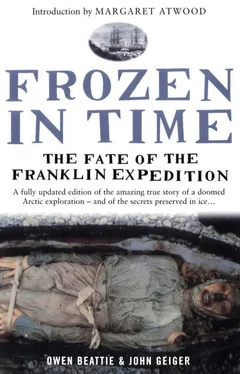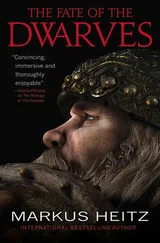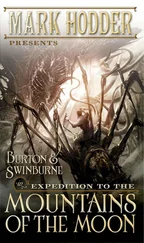For it was here, in 1848, that the finely outfitted and trained British Arctic expedition commanded by Sir John Franklin ended in extraordinary tragedy. Not one of the 129 men came out of the Arctic to tell of their accomplishments or suffering, and both of the expedition’s ships, HMS Erebus and HMS Terror, were lost, as were whatever written accounts of the journey that had existed. British and American searchers grasping to understand the disappearance were confounded by what little remained of the expedition. Sketchy stories told by the native Inuit, some artefacts, human remains and one tragic note found by nineteenth-century searchers are all that historians have been able to rely on for their reconstruction of events.
Walking along the gravel and sand beaches on a blustery and near freezing June day in 1981, members of an archaeological team from the University of Alberta surveyed a spit of land near Booth Point, on the south coast of King William Island, for human skeletal remains. They hoped their research would uncover clues to the events of the expedition’s agonizing final days. They knew that some of the last survivors had crossed from here to a place on the mainland known as Starvation Cove, where the tragedy had reached its inevitable conclusion. The researchers were following the lead of one of the early Franklin searchers, an American explorer named Charles Francis Hall, who in 1869 recorded an Inuit account of a grave belonging to a member of the lost expedition:
After traveling about half an hour, the party halted on a long low spit, called by the natives Kung-e-ark-le-ar-u, on which the men… ‘knew that a white man had been buried.’ This, however, was chiefly from the accounts which they had had from their people; only one of these had ever seen the grave. The spot was pointed out, but the snow covered all from view. A monument was erected, and its bearings… carefully noted.
The first day of survey work in 1981 failed to turn up anything. It was on the second morning, 29 June, that field assistant Karen Digby walked up to forensic anthropologist Owen Beattie and archaeologist James Savelle clutching what looked like a broken china bowl in her right hand. “I think this is something important. Is it human?” Digby asked as she handed the white skull bone to Beattie.
It was the first major discovery of their fieldwork, representing the starting point of Beattie’s forensic investigation. Having marked the location of her find, Digby led the rest of the crew to the spot. Still visible in the sandy soil was the depression where the human skull fragment had rested, and, placing the discovery back in the depression, the researchers began the process of meticulously searching the finger of land for other remains.
At first, only a few fragments of bone were found. But after six hours of careful survey work, in which every inch of ground was covered, the researchers had discovered, photographed, mapped and then collected thirty-one pieces of human bone. Most of the remains were found exposed on the surface, others were hidden by occasional pockets of vegetation or had been nearly swallowed by the sand.
The texture of the bone illustrated the severity of the northern climate. Exposed portions were bleached white, and powdery flakes of the outer bone surface cracked and fell off if handled too roughly. Sharing the exposed surfaces were small and brightly coloured colonies of mosses and lichens, anchored firmly on the sterile white of the bone as if braced for another harsh winter. By contrast, the ivory-brown undersides of the bones, never exposed to the sun or elements, were found to be in extremely good condition, with all anatomical detail preserved. The researchers also discovered several artefacts at the site, including a shell button common in the early and mid-nineteenth century and a clay pipe stem like those carried on the Franklin expedition. The skeletal remains and artefacts were found over a 33- by 50-foot (10- by 15-metre) area, at the centre of which lay the remnants of what had been a stone tent circle.
One of the first and most important questions that forensic anthropologists ask when examining human remains is, “How many individuals are represented?” Carefully studying the remains, Beattie was able to determine that there were no duplications of bones or anatomical features and that the size and characteristics of the bones supported the theory that they belonged to a single individual.
The shape of the skull’s frontal bone and characteristics of the eye socket revealed the remains to be likely of European ancestry. Heavy brow ridges and well-developed muscle markings on the skull and limb bones identified the skeleton as male. The skull sutures (the joints between the various bones of the skull that slowly disappear as an individual grows older) were still clearly visible, indicating that the individual was only twenty to twenty-five years of age at the time of his death.
To many, skeletal remains of a Franklin sailor would serve only as an intimation of a distant Arctic disaster. But to Beattie, the discovery of the Booth Point skeleton was as if one of the last of Franklin’s crewmen to die had come forward through time to answer his questions. For there was evidence of metabolic stress, suggestive of serious dietary problems, in porous lesions on the orbital roofs of the skeleton. (Such lesions are associated with various anaemias, but most particularly with iron deficiency anaemia.) There was also the first physical evidence ever discovered that supported the long-held belief among historians that expedition members suffered from the debilitating effects of scurvy during their final months. Areas of shallow pitting and scaling on the outer surfaces of the bones were like those seen in documented cases of vitamin C deficiency, the cause of scurvy. Bone changes due to inflammation (called periostitis) of the thin, parchment-like skin adhering tightly to the surface of living bone, were also easily identified. Other bone changes showed the effects of haemorrhaging between this thin skin and the long bone surfaces. With scurvy, these subperiosteal haemorrhages and resulting bone remodelling can occur even during the physical stresses and strains of everyday activities.
The tremendous impact of scurvy was felt throughout much of the period of European expansion and maritime exploration, which started in the sixteenth century. The diet of the mariners of the age, who endured long voyages without fresh fruit and vegetables, made them particularly susceptible to the ravages of the disease. More Royal Navy charges succumbed to this scourge than died in battle in the eighteenth century. When British commodore George Anson led a squadron into the Pacific in the 1740s to raid Spanish shipping routes, for instance, he lost thirteen hundred men out of his entire two thousand complement to scurvy. In his account of that voyage, Anson’s expedition chaplain, Richard Walter, provides a grisly inventory of the symptoms, including ulcers, rictus of the limbs, spontaneous haemorrhages in almost all parts of the body—and a bloom of gum tissue that enveloped what teeth had not already fallen out, producing a terrible odour. Walter also noted strange sensory and psychological effects. The smell of lotus blossoms wafting from the shore caused men to writhe in agony; the sound of a musket firing could be fatal to patients with advanced cases. The sailors also found themselves crying inconsolably at the slightest provocation and swept by hopeless longings.
Unknown until 1917 was the root cause: Scurvy is the result of a deficiency of vitamin C (ascorbic acid), which today can be effectively cured within twenty-four hours with the intake of large doses of the vitamin. In 1753, Scottish physician James Lind published his classic A Treatise on the Scurvy, in which he advanced the plausibility of such a treatment by providing experimental proof of the benefits of citrus juice as an antiscorbutic. The Royal Navy, which one critic would later damn as “a hierarchy as soul-chilling, as rigorous, as iron-bound, as any Brahmin caste,” initially failed to reform dietary regimens, however, with the result that the disease continued to wreak havoc. Only in 1795 did the Royal Navy heed decades of advice and begin enforcing the consumption of lime juice on its ships (giving rise to the term “limey”).
Читать дальше










